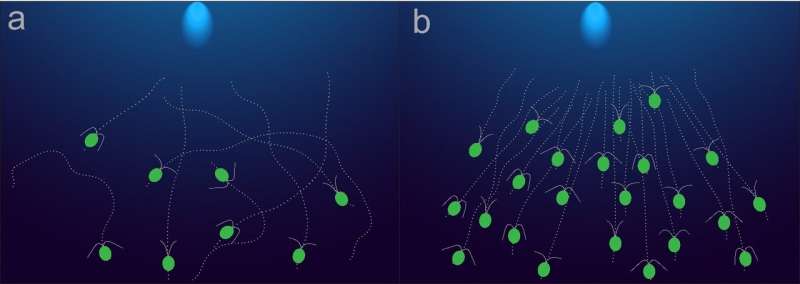The simple physics behind algal movement towards light

A new study from the Indian Institute of Science (IISc) describes how certain algae collectively sense and respond to light, a phenomenon called phototaxis.
For decades, a single-celled green alga called Chlamydomonas reinhardtii has helped scientists understand fundamental biological processes, make biofuels and drugs, even investigate brain disorders. This freshwater protist has been a particularly useful model to study how organisms sense and move towards light. As it swims, its body rotates about its own axis, while an organelle called the eyespot scans the water for light like a radar antenna, and prompts the cell to move towards the source.
When a large number of C. reinhardtii cells are suspended in a liquid medium—inside a biofuel reactor, for example—how do they collectively respond to light, and what factors influence their efficiency? Above a critical cell concentration, the fraction of cells moving towards light—a measure of phototactic efficiency—starts increasing steadily. This happens because the cells start to swim more slowly, allowing them to sense light more accurately, the study has found.
"If they move slowly, they also rotate and scan slowly. Therefore, they have a greater chance of detecting the photons from the light source," says Prerna Sharma, Assistant Professor at the Department of Physics, and senior author of the study published in the Biophysical Journal.
Using high-speed cameras coupled to a microscope, Sharma and her team in collaboration with Aparna Baskaran, Associate Professor, Brandeis University, tracked the movement of individual C. reinhardtii cells suspended in a fluidic chamber under varying light intensities. When there were very few cells, the fraction of individuals moving towards the light was found to be low. One possible explanation is that the cells crowd each other, which reduces the amount of light reaching each cell, the authors suggest.
Beyond a certain threshold (about a million cells per cubic cm), however, the fraction of cells moving towards the light was found to rise steadily as the cell concentration increased. This increase matched a steady decrease in the cells' swim speeds, indicating that they were slowing down as their numbers went up, the researchers found. Slowing down cell movement by making the medium more viscous, for example, also helped boost their phototactic efficiency, they found.
"Phototaxis is important even in artificial systems such as micro-propellers or micro-robots," says Sujeet Kumar Choudhary, first author and Ph.D. student at the Department of Physics, IISc. For example, researchers have developed robot swarms that can, among other things, sense and move towards light. "Some of these physical principles can be applied to such systems," he says.
More information: Sujeet Kumar Choudhary et al. Reentrant Efficiency of Phototaxis in Chlamydomonas reinhardtii Cells, Biophysical Journal (2019). DOI: 10.1016/j.bpj.2019.09.016
Journal information: Biophysical Journal
Provided by Indian Institute of Science



















